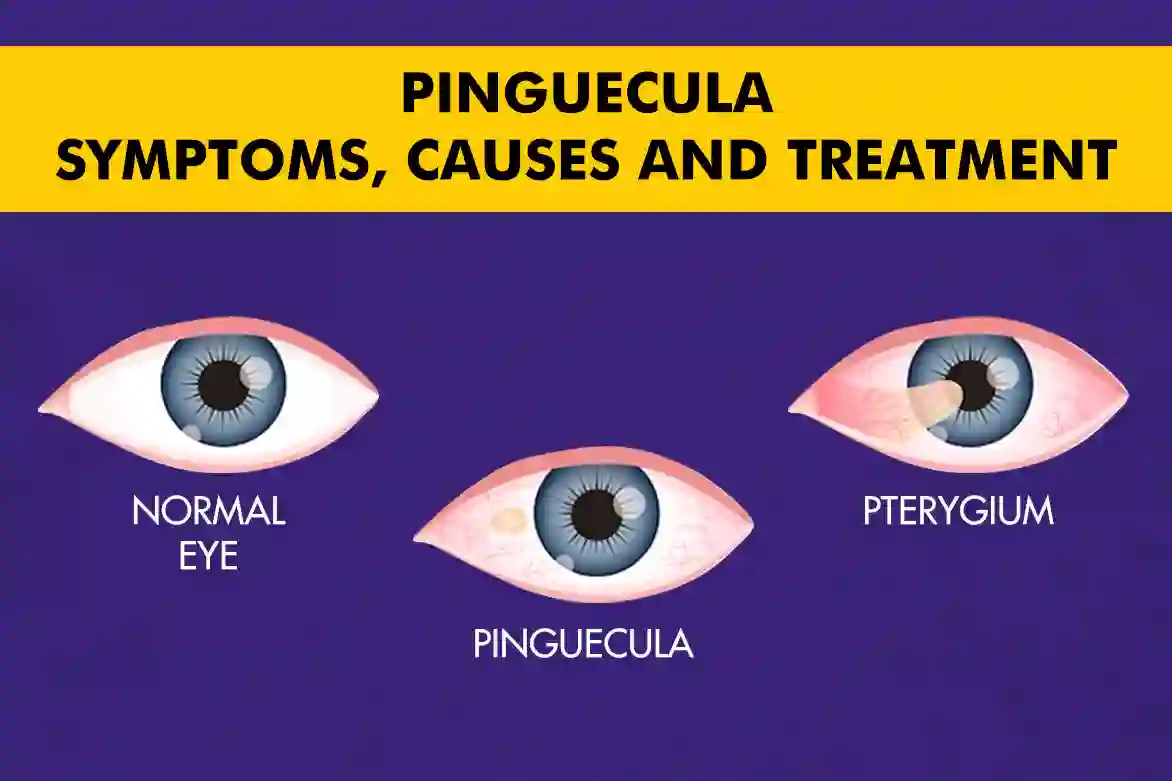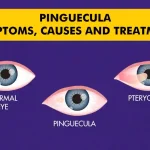Pinguecula is a common eye condition that affects the conjunctiva, the thin, transparent membrane that covers the white part of the eye and the inner surface of the eyelids. It appears as a yellowish or whitish bump on the conjunctiva, usually on the side closer to the nose. This condition is benign and typically doesn’t cause any serious vision problems.
While pinguecula eye is generally harmless, it can be a source of discomfort and affect the appearance of the eye. Understanding the symptoms, causes, and pinguecula treatment options can help individuals manage this condition effectively.
What Is Pinguecula?
Pinguecula is thought to be caused by long-term exposure to UV radiation from the sun, wind, and dust. These environmental factors can cause changes in the conjunctiva, leading to the formation of pinguecula eyes. This condition is more common in people who spend a lot of time outdoors, such as farmers, fishermen, and those living in sunny climates.
Pinguecula is also more prevalent in older individuals, as the conjunctiva naturally becomes more thickened and less elastic with age. Other risk factors for pinguecula include a history of chronic eye irritation and dry eyes.
Common Symptoms of Pinguecula
Pinguecula is typically asymptomatic, meaning it doesn’t cause any noticeable symptoms in most cases. However, some individuals may experience the following pinguecula symptoms:
- A yellowish or whitish bump on the conjunctiva
- Irritation or a gritty sensation in the eye
- Dryness or burning sensation
- Redness or inflammation
- Blurred vision (rare)
Know more about yellow eyes.
Causes of Pinguecula
The exact cause of pinguecula is not fully understood, but it is believed to be primarily caused by long-term exposure to UV radiation and environmental factors such as wind and dust. These factors can lead to changes in the conjunctiva, resulting in the development of pinguecula. Other factors that may contribute to the development of pinguecula include:
- Aging, as the conjunctiva becomes less elastic and more prone to changes
- Chronic eye irritation, which can cause inflammation
- Dry eyes, which can lead to conjunctival changes
- Prolonged exposure to certain chemicals or pollutants
Difference Between Pterygium and Pinguecula
Pterygium and pinguecula are both eye conditions that affect the conjunctiva, but they have some key differences. While pinguecula eyes appear as a yellowish or whitish bump on the conjunctiva, pterygium is a growth of fleshy tissue that extends onto the cornea, the clear front surface of the eye.
Pterygium is often more noticeable than pinguecula and can cause more significant vision problems if it grows large enough to cover the cornea. Unlike pinguecula, pterygium can also cause astigmatism, a refractive error that results in blurred vision.
You can learn more about the Cornea Transplant here.
Also go through the eye exercises for astigmatism.
Diagnosis of Pinguecula
Pinguecula eye is usually diagnosed through a comprehensive eye examination conducted by an eye care professional. The eye doctor will examine the eyes using a slit lamp, a special microscope that provides a magnified view of the eye structures.
During the examination, the doctor will look for the characteristic yellowish or whitish bump on the conjunctiva. They may also check for any signs of inflammation or other eye conditions that may be causing similar symptoms.
How to Treat Pinguecula
In most cases, pinguecula eyes do not require treatment and do not cause any significant vision problems. However, if it is causing discomfort or affecting the quality of life, there are several pinguecula treatment options available, including:
- Lubricating eye drops or artificial tears to relieve dryness and irritation
- Nonsteroidal anti-inflammatory drugs (NSAIDs) to reduce inflammation
- Topical steroids for short-term use to alleviate inflammation
- Surgical removal of pinguecula (rarely necessary, reserved for severe cases)
You can read about uveitis here which is a inflammatory condition that affects the uvea.
Preventive Measures for Pinguecula
While it may not be possible to completely prevent pinguecula eyes, there are several strategies that can help reduce the risk or minimize the symptoms:
- Wearing sunglasses with UV protection to shield the eyes from harmful UV rays
- Using protective eyewear, such as goggles, when engaging in activities that may expose the eyes to dust, wind, or chemicals
- Practicing good eye hygiene, including regularly washing hands and avoiding rubbing the eyes
- Using lubricating eye drops to keep the eyes moist and prevent dryness
- Seeking prompt medical attention if experiencing persistent eye irritation or discomfort
Also read about the home remedies for eye irritation.
Here are the tips to choose the right sunglasses.
Conclusion
Pinguecula is a common and generally harmless eye condition that appears as a yellowish or whitish bump on the conjunctiva. While it may not cause significant vision problems, it can be a source of discomfort and affect the appearance of the eye. Understanding the symptoms, causes, and pinguecula treatment options can help individuals manage it effectively.
If you are experiencing any symptoms or have concerns about your eye health, it is important to consult with an eye care professional for a proper diagnosis and appropriate management.
FAQs
What is the treatment for pinguecula?
The treatment for pinguecula usually involves managing the symptoms, such as using lubricating eye drops and avoiding irritants. In severe cases, surgical removal of pinguecula may be considered.
Can pinguecula be removed?
In some cases, surgical removal of pinguecula may be necessary if it is causing significant discomfort or affecting vision. However, this is rare and reserved for severe cases.
Is pinguecula a tumor?
No, pinguecula is not a tumor. It is a benign growth on the conjunctiva and is generally harmless.
What happens if pinguecula goes untreated?
Pinguecula typically does not require treatment and does not cause significant vision problems. However, if left untreated, it may continue to cause discomfort or affect the appearance of the eye.
Can pinguecula go away naturally?
Pinguecula does not usually go away on its own. However, it may remain stable or even shrink in size over time.
Is pinguecula eye serious?
Pinguecula is generally not considered a serious eye condition. While it may cause discomfort and affect the appearance of the eye, it does not typically lead to serious complications or vision loss.





